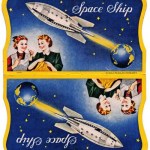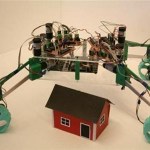space
Dynamic of the Cats as some commentary on the LCROSS landing the moon. The "big news" is the very high confidence now that one can put on the proposition that the moon does have water. Since humans are mostly water by weight, this is very important when assessing the practical difficulties of colonization or settlement. Would have been a drag to lug or synthesize H2O.
I notice that the NOVA documentary, Is there life on Mars?, is viewable online (from December 2008). Check it out.
Stacy L. Mason is an Aard regular and a talented artist. Check out his awesome interpretation of the Swedish tardigrades that are going to Phobos!
In other news, I have issues with the lyrics of the Kick-Ass Mystic Ninjas podcast's theme song, a fine ska tune by 7 Seconds of Love.
I'm gonna flip out like a ninja
'Cause that's what ninjas do
I'm gonna flip out like a ninja
And you should flip out too
The thing that throws me here is the word "because". When deciding on important matters such as whether or not to flip out, Dear Reader, I feel that a person should have a stronger justification…
Phobos-Grunt ("soil") is a planned Russian sample return mission to the Martian moon Phobos. It may launch in less than two months. On board will among other things be the L.I.F.E. experiment, a small canister full of hardy micro organisms, designed by the US Planetary Society. If all goes well, those microdaddies will go to Phobos and back, and then biologists will be able to compare them to their stay-at-home buddies to learn what the environment out there in interplanetary space really does to an Earth creature. Or to a creature from another planet who might once have been thrown into…
Did you notice something funny about the Google logo yesterday? It was full of falling stars. This marked the maximum of this year's Perseid meteor shower. Every year about this time, Earth moves through the exhaust cloud left behind by the comet Swift-Tuttle. When gravel and sand from the comet enters our atmosphere the grains burn brightly, looking like shooting stars. The meteor shower, that has been known for over 2000 years, looks like it originates in the constellation named for the Greek hero Perseus. But Swift-Tuttle itself wasn't observed until 1862!
Last night before bed time me and…
I just listened to a radio segment on public sentiments toward the Apollo space program expenditures in hindsight. The polling had a small N, 3 people in Los Angeles on the street. But it got me wondering: who supports the space program? There is a variable in the GSS, NATSPAC, with a large sample size, which states:
We are faced with many problems in this country, none of which can be solved easily or inexpensively. I'm going to name some of these problems, and for each one I'd like you to tell me whether you think we're spending too much money on it, too little money, or about the right…
Moon astronauts urge Mars mission:
At a rare public reunion of the Apollo 11 crew, Buzz Aldrin and Michael Collins said Mars instead of the Moon should be the focus of exploration.
Neil Armstrong, the first man on the Moon, said the race to get to the Moon had been the ultimate peaceful contest.
He said it was an "exceptional national investment" for the US and ex-USSR.
The trio spoke at an event at Washington's National Air and Space Museum to mark the 40th anniversary of their mission.
Mr Armstrong told the audience: "It was the ultimate peaceful competition: USA vs USSR.
Apparently 4 out…
Hawaii Looks to Space Tourism to Aid Recession Woes:
According to the Honolulu Advertiser, the state would start by spending up to a million dollars developing a spaceport.
But Hawaii isn't alone: The state is already facing heady competition from states including Florida, Okalahoma and New Mexico, all of which are moving into the space tourism market.
Hawaii has one comparative advantage: it's further south. I recall that the increased velocity of the earth's rotation the closer you get to the equator means that you get some energy for lift-off for free. This is why the French launch their…
tags: Biosphere 2, environment, biophilia, green living, Jane Poynter, TEDTalks, streaming video
In this video, Jane Poynter tells her story of living two years and 20 minutes in Biosphere 2 -- an experience that provoked her to explore how we might sustain life in the harshest of environments. This is the first TED talk drawn from an independently organized TEDx event, held at the University of Southern California. [15:54]
TEDTalks is a daily video podcast of the best talks and performances from the TED Conference, where the world's leading thinkers and doers give the talk of their lives…
Seed's Mr. Space Lee Billings has an interesting piece, The Long Shot:
"If planets are found around Alpha Centauri, it's very clear to me what will happen," Marcy said. "NASA will immediately convene a committee of its most thoughtful space propulsion experts, and they'll attempt to ascertain whether they can get a probe there, something scarcely more than a digital camera, at let's say a tenth the speed of light. They'll plan the first-ever mission to the stars."
The premise seems to verge on science fiction. But then much of science could be fiction if it weren't fact. In any case, some…
In 1976, NASA Administrator James Fletcher noted that "The question, 'What is feasible?' can be finally answered only by future historians." He was talking about the elaborate plans for space habitats the agency had spent a summer noodling over, but the same remark could have been made to the incredulous before the first moon landing, for example -- or before the birth of transoceanic voyages in the 14th and 15th Centuries.
So begins of one of my favorite pieces of utopist NASA detritus, a document called Space Settlements: A Design Study, made over the course of a 10-week workshop at the…
I find this 1950s-era needle book cover fascinating, because it mixes the stereotypically female activity of sewing with the stereotypically male interest in space travel. What is the connection here? Are these young women sewing spacesuits? Are they inspired by/chatting about the excitement of rocket science? Is there any tenuously plausible connection that can be made between a space ship named "The Moon" and sewing needles, other than that they are both silver?
View larger image
Ha! It turns out we can't even make that connection, because a closer look at the packaging reveals that the…
Swedish researchers have enlisted the help of artist Mikael Genberg to design a robot that will one day erect a tiny house on the moon. After landing on the lunar surface in 2012, the autonomous robot will scout for a suitable location and build a small red cottage, in keeping with the Scandinavian style.
The flatly-named The House on the Moon project aims to be a symbol of what one man can achieve. Students at the Mälardalen University will design, build and program the robot, although Professor Lars Asplund hinted that the final step may be a leap too far:
"We want to teach students who…
The stratosphere, as photographed by a group of four Spanish schoolboys, or their balloon, anyway.
Well, okay, maybe it's citizen space photography instead of citizen science. But still. Gotta love this. From the Telegraph:
Proving that you don't need Google's billions or the BBC weather centre's resources, the four Spanish students managed to send a camera-operated weather balloon into the stratosphere.
Taking atmospheric readings and photographs 20 miles above the ground, the Meteotek team of IES La Bisbal school in Catalonia completed their incredible experiment at the end of February…
Phil Plait over at Bad Astronomy posted this terrific piece that started off my Saturday with a smile. It reads like The Onion, though I also can't find the original source. Take a look and see if you agree that author Michael Haber might be onto something...
Emboldened by their success in declaring Pluto not a
planet, the International Astronomical Union determined this week by a
close vote that February is too short to be considered a true month. It
has, however, been granted the newly created status of "dwarf month."
It shares this dubious distinction with several other calendar time…
I LOVE all things space--arguably more than the next girl. For years I wanted to be an astrobiologist. Infinite possibilities and the ultimate opportunity to explore the unknown. And it's no secret to readers that I adore Carl Sagan and Cosmos, which fostered a love and appreciation of science in so many of us.
All I'm saying is, just perhaps--for the time being--we might be better off spending the kind of figures currently invested in large scale BIG 'what if?' projects on more proximate concerns. No doubt the mission of Kepler is really cool, but why rush to search for planets like…
I'll admit PZ's post yesterday featuring a cosmic cephalopod sleeping overhead in the Carina Nebula was both daunting and impressive... but never fear friends, a heroic starry sea cucumber keeps vigilant in the Crab Pulsar and continues to protect us from its merciless tentacles.
In lieu of blasting the Washington Post again over their recent faux pas, I'm interested in finding out whether you're as intrigued as I am lately over LOST...
During my recovery, I've been catching up on past episodes and this season includes a lot of 'science' in the script as the island jumps through time and space. And what is the DHARMA Initiative? Presently, we've got a physicist wandering through the jungle, years that span days, and the occasional troublesome nosebleed. All of which has inspired wide speculation about what's really going on.
Regular Intersection readers know this…
In my last post I remarked on how "radically strange--and yet strangely modern" I expected the 1543 work that kicked off the "scientific revolution" to be. Now that I've read the first two books of De Revolutionibus, I can say, boy was I right.
This is the first of several posts about my experience of reading Nicholaus Copernicus in the original (er, translation). So first, let me point out the things I found "radically strange" about the work, with the "strangely modern" to come in the next post:
Radically strange: Instructions for how to build an astrolabe. Vast tables of star locations,…

